Mobile, Alabama, Hgh State Clinic, Hgh Injections, Hrt Doctors
Mobile, Alabama Blood Testing Facilities
 Represents a LabCorp blood testing facility
Represents a LabCorp blood testing facility Represents a Quest Diagnostics blood testing facility
Represents a Quest Diagnostics blood testing facility

Nearby Labcorp Blood Testing facilities:
- Labcorp Center Distance: 1 m, 1504 Springhill Ave 1700, Mobile, Mobile County, AL, 36604
- Labcorp Center Distance: 5 m, 1201 Montlimar Dr Ste 175, Mobile, Mobile County, AL, 36609
- Labcorp Center Distance: 9 m, 6701 Airport Blvd Ste A-106, Mobile, Mobile County, AL, 36608
- Labcorp Center Distance: 15 m, 306 South Greeno Rd. Suite B, Fairhope, Baldwin County, AL, 36532
- Labcorp Center Distance: 28 m, 1851 North Mckenzie St 102, Foley, Baldwin County, AL, 36535
- Labcorp Center Distance: 36 m, 156 East 15Th Avenue Suite 5, Gulf Shores, Baldwin County, AL, 36542
- Labcorp Center Distance: 52 m, 3437 North 12Th Avenue, Pensacola, Escambia County, FL, 32503
- Labcorp Center Distance: 67 m, 1110 Broad Ave Ste 300, Gulfport, Harrison County, MS, 39501
- Labcorp Center Distance: 85 m, 339 Racetrack Rd Nw Ste 21, Fort Walton Beach, Okaloosa County, FL, 32547
- Labcorp Center Distance: 87 m, 1505A S Ferdon Blvd, Crestview, Okaloosa County, FL, 32536
- Labcorp Center Distance: 94 m, 1010 West 1St Street, Laurel, Jones County, MS, 39440
Nearby Quest Blood Testing facilities:
- Quest Center Distance: 7 m, 124 South University Blvd, Mobile, Mobile County, AL, 36608-3088
- Quest Center Distance: 28 m, 1506 N Mckenzie St, Foley, Baldwin County, AL, 36535-2264
- Quest Center Distance: 52 m, 4900 Bayou Blvd, Pensacola, Escambia County, FL, 32503-2533
- Quest Center Distance: 53 m, 418 E. Gregory Street, Pensacola, Escambia County, FL, 32502-4902
- Quest Center Distance: 57 m, 5950 Berryhill Rd, Milton, Santa Rosa County, FL, 32570-4009
- Quest Center Distance: 65 m, 12207 Highway 49, Gulfport, Harrison County, MS, 39503-2955
- Quest Center Distance: 85 m, 348 Miracle Strip Pkwy Sw, Fort Walton Beach, Okaloosa County, FL, 32548-5200
Mobile Alabama Hormone Replacement Therapy Services
For someone that is just considering Hormone Optimization with HGH and Testosterone, the process of finding a reputable Hormone Clinic in your area can be daunting. The Conscious Evolution Institute specializes in providing our patients with the HRT Services that they both need and deserve, all offered remotely and at a price that they can afford.
We are able to achieve our goals of efficient, reliable, and effective care through our logisitical capability to match you with a local affiliate in the Mobile Area that can act as an intermediary on our behalf. They will perform the physical examination and draw a blood sample, and we will use all of this information in order to provide a reliable Hormone Deficiency Diagnosis on your behalf.
If you qualify for Bio-Identical HGH, Testosterone Replacement, or any other form of Hormone Restoration that we offer through our clinic, we can write you a prescription for legal and affordable Hormone Products delivered discretely and directly to your chosen address. Don't fall victim to Hormone Imbalance, turn to the Conscious Evolution Institute for your legal HGH and Testosterone Prescriptions!
Mobile Alabama Testosterone Therapy Clinics for Low-T and Andropause
Testosterone Deficiency is routinely associated with sexual dysfunction, but too many American Men are unaware of the dangerous risks associated with Low-T. Males with Testosterone Deficiency are more likely to have high cholesterol or suffer from heart attack and stroke. They are more likely to suffer from psychological issues such as anxiety, depression, and lack of confidence. Men with Low Testosterone Levels are more likely to obese, fatigued, and diabetic than their counterparts with normal Testosterone Production.
Don't let your embarrassment regarding your sexual inadequacy prevent you from getting the real and pertinent care that you need. We can diagnose your Testosterone Deficiency and provide you with Testosterone Creams, Patches, or Injections that can relieve your Low-T, improve your sexual performance, and enhance your health and wellbeing.
Mobile Prescription Human Growth Hormone Replacement Therapy for Hypogonadism
In addition to our fine Testosterone Products, we also provide quality Bio-Identical HGH Therapy, which is designed to relieve the unhealthy symptoms of Growth Hormone Deficiency which have been proven to impede health and longevity for aging men and women. Human Growth Hormone keeps the body functioning at peak condition, and as HGH Levels drop with age, this leads to inevitable drop in physiological function which reveals itself through the numerous symptoms of Growth Hormone Deficiency.
Symptoms of Abnormally Low HGH Levels include depression, weight gain, lack of energy, loss of strength and muscle tone, increased incidence of sickness and illness, reduced ability to recover from injury, restlessness, and even a decline in cognitive function. HGH Injection Therapy with Nutropin, Omnitrope, and other brand name Growth Hormone Products is designed to effectively restore normal HGH Levels and get your life and your wellness back on track.
Mobile Sermorelin for HGH Deficiency Treatment
Also ask about Sermorelin Acetate, a Recombinant HRT Therapy which has been clinically proven to be an effective alternative to Bio-Identical Growth Hormone. Sermorelin works by helping the body produce its own natural Human Growth Hormone, bypassing the need for direct injection of the hormone into the bloodstream via subcutaneous injection. Sermorelin has proven itself to be reliable and cost-effective, and it can even be prescribed off-label at the discretion of your Hormone Specialist!
Mobile Information
Mobile is located in Southwest Alabama in a county of the same name. Mobile is the only port in the state of Alabama that is located on saltwater, and is one of the largest and most important ports in the Gulf of Mexico. Mobile goes by many nicknames. It is known as the City of Six Flags because Mobile has been under the sovereignty of six different nations, including the United States, the Confederacy, France, and Spain. The city is also known as the Port City and the Azalea City. Mobile is the third biggest city in the state of Alabama behind only Birmingham and Huntsville in population.
Suburbs of Mobile include Spanish Fort, Daphne, Theodore, Chickasaw, Saraland, and Satsuma. Amon gthe many neighborhoods of Mobile are Seven Hills, Navco, Spring Hill, Park Hill, Thorn Hill, and Country Club Estates. Places of interest in Mobile include the Bragg-Mitchell Mansion, the Mobile Carnival Museum, and the Mobile Museum of Art. Perhaps the most notable landmark in Mobile is the U.S.S. Alabama, a World War Two Battleship that has been decommissioned and sits on the coast of Blakely Island at the Battleship Memorial Park.
Mobile and New Orleans: Sister Cities
The city shares many characteristics with other coastal cities in the region that make it unique to more inland areas of Alabama. Mobile and New Orleans actually share more in common than Mobile and the rest of the state. Both cities are renowned for their immense Spanish and French influence. Both cities have a huge Mardi Gras Celebration Every year as well. In fact, even though Mardi Gras is most associated with New Orleans, it was first celebrated in Mobile.
One of the quirkiest events in Mobile occurs during the New Years celebration. Instead of dropping a ball to ring in the New Year, Mobile actually lowers a giant Moon Pie, which is a classic dessert which was created in the city and destributed throughout the South.
Higher Education in Mobile
The largest university in Mobile is the University of South Alabama. Along with UAB in Birmingham, USA is the only other school to offer a Med School Program in the state. The The University of Alabama belongs to the Sunbelt Conference, and the mascot of the school are the Cougars. Other locations of higher education in Mobile include Faulkner University and Spring Hill College.
All About Mobile, Alabama Geographic Area
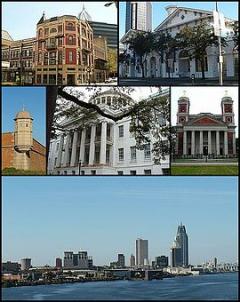
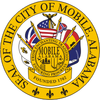
Mobile ( /moÊoËnbiËal/ moh-BEEL) is the third most populous city in the U.S. state of Alabama and is the county seat of Mobile County. It is located on the Mobile River and the central Gulf Coast of the United States. The population within the city limits was 195,111 during the 2010 census. It is the largest municipality on the Gulf Coast between New Orleans, Louisiana, and St. Petersburg, Florida. Mobile is the principal municipality of the Mobile Metropolitan Statistical Area, a region of 412,992 residents which is composed solely of Mobile County and is the third largest metropolitan statistical area in the state. Mobile is included in the Mobile-Daphne aeFairhope Combined Statistical Area (CSA). The combined statistical area has a total population of 591,599, also the second largest in the state.
/moÊoËnbiËal/ moh-BEEL) is the third most populous city in the U.S. state of Alabama and is the county seat of Mobile County. It is located on the Mobile River and the central Gulf Coast of the United States. The population within the city limits was 195,111 during the 2010 census. It is the largest municipality on the Gulf Coast between New Orleans, Louisiana, and St. Petersburg, Florida. Mobile is the principal municipality of the Mobile Metropolitan Statistical Area, a region of 412,992 residents which is composed solely of Mobile County and is the third largest metropolitan statistical area in the state. Mobile is included in the Mobile-Daphne aeFairhope Combined Statistical Area (CSA). The combined statistical area has a total population of 591,599, also the second largest in the state.
Mobile began as the first capital of colonial French Louisiana in 1702. The city gained its name from the Native American Mobilian tribe that the French colonists found in the area of Mobile Bay. During its first 100 years, Mobile was a colony for France, then Britain, and lastly Spain. Mobile first became a part of the United States of America in 1810, with the annexation of West Florida under President James Madison. It then left that union in 1861 when Alabama joined the Confederate States of America, which collapsed in 1865.
Located at the junction of the Mobile River and Mobile Bay on the northern Gulf of Mexico, the city is the only seaport in Alabama. The Port of Mobile has always played a key role in the economic health of the city beginning with the city as a key trading center between the French and Native Americans down to its current role as the 9th-largest port in the United States.
As one of the Gulf Coast's cultural centers, Mobile has several art museums, a symphony orchestra, a professional opera, a professional ballet company, and a large concentration of historic architecture. Mobile is known for having the oldest organized carnival celebrations in the United States, dating to the 18th century of its early colonial period. It was also host to the first formally organized Carnival mystic society or "krewe" in the United States, dating to 1830. People from Mobile are known as Mobilians.
The European settlement of Mobile, then known as Fort Louis de la Louisiane, started in 1702, at Twenty-seven Mile Bluff on the Mobile River, as the first capital of the French colony of Louisiana. It was founded by French Canadian brothers Pierre Le Moyne d'Iberville and Jean-Baptiste Le Moyne, Sieur de Bienville, to establish control over France's Louisiana claims. Bienville was made governor of French Louisiana in 1701. Mobile's Roman Catholic parish was established on 20 July 1703, by Jean-Baptiste de la Croix de Chevrieres de Saint-Vallier, Bishop of Quebec. The parish was the first established on the Gulf Coast of the United States. In 1704 the ship Pelican delivered 23 French women to the colony, along with yellow fever which passengers had contracted at a stop in Havana. Though most of the "Pelican girls" recovered, numerous colonists and neighboring Native Americans died from the illness. This early period was also the occasion of the arrival of the first African slaves, transported aboard a French supply ship from Saint-Domingue. The population of the colony fluctuated over the next few years, growing to 279 persons by 1708, yet descending to 178 persons two years later due to disease.
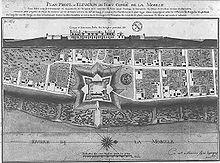
These additional outbreaks of disease and a series of floods caused Bienville to order the town relocated several miles downriver to its present location at the confluence of the Mobile River and Mobile Bay in 1711. A new earth and palisade Fort Louis was constructed at the new site during this time. By 1712, when Antoine Crozat took over administration of the colony by royal appointment, the colony boasted a population of 400 persons. The capital of Louisiana was moved to Biloxi in 1720, leaving Mobile in the role of military and trading center. In 1723 the construction of a new brick fort with a stone foundation began and it was renamed Fort Conde in honor of Louis Henri, Duc de Bourbon and prince of Conde.
In 1763, the Treaty of Paris was signed, ending the French and Indian War. The treaty ceded Mobile and the surrounding territory to Great Britain, and it was made a part of the expanded British West Florida colony. The British changed the name of Fort Conde to Fort Charlotte, after Charlotte of Mecklenburg-Strelitz, King George III's queen.
The British were eager not to lose any useful inhabitants and promised religious tolerance to the French colonists, ultimately 112 French Mobilians remained in the colony. The first permanent Jewish presence in Mobile began in 1763 as a result of the new religious tolerance. Jews had not been allowed to officially reside in colonial French Louisiana due to the Code Noir, a decree passed by France's King Louis XIV in 1685 that forbade the exercise of any religion other than Roman Catholicism, and ordered all Jews out of France's colonies. Most of these colonial era Jews in Mobile were merchants and traders, and added to the commercial development of Mobile. In 1766 the population was estimated to be 860, though the town's borders were smaller than they had been during the French colonial efforts. During the American Revolutionary War, West Florida and Mobile became a refuge for loyalists fleeing the other colonies.
While the British were dealing with their rebellious colonists along the Atlantic coast, the Spanish entered the war as an ally of France in 1779. They took the opportunity to order Bernardo de Galvez, Governor of Louisiana, on an expedition east to retake Florida and captured Mobile during the Battle of Fort Charlotte in 1780 as part of this campaign. They wished to eliminate any British threat to their Louisiana colony, which they had received from France in the 1763 Treaty of Paris. Their actions were also condoned by the revolting American colonies, as evidenced by the presence of Oliver Pollack, representative of the American Continental Congress, and because West Florida, for the most part, remained loyal to the British Crown. The fort was renamed Fortaleza Carlota, with the Spanish holding Mobile as a part of Spanish West Florida until 1813, when it was seized by the U.S. General James Wilkinson during the War of 1812.
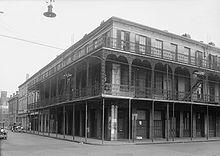
By the time Mobile was included in the Mississippi Territory in 1813, the population had dwindled to roughly 300 people. The city was included in the Alabama Territory in 1817, after Mississippi gained statehood. Alabama was granted statehood in 1819; Mobile's population had increased to 809 by that time. As the river frontage areas of Alabama and Mississippi were settled by farmers and the plantation economy became established, Mobile's population exploded. It came to be settled by merchants, attorneys, mechanics, doctors and others seeking to capitalize on trade with these upriver areas. Mobile was well situated for trade, as its location tied it to a river system that served as the principal navigational access for most of Alabama and a large part of Mississippi. By 1822 the city's population was 2800.
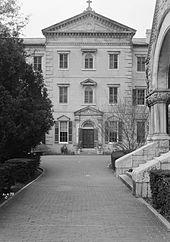
From the 1830s onward, Mobile expanded into a city of commerce with a primary focus on the cotton trade. A building boom was underway by the mid-1830s, with the building of some of the most elaborate structures the city had ever seen up to that point. This was cut short in part by the Panic of 1837 and yellow fever epidemics. The waterfront was developed with wharves, terminal facilities, and fireproof brick warehouses. The exports of cotton grew in proportion to the amounts being produced in the Black Belt; by 1840 Mobile was second only to New Orleans in cotton exports in the nation.
With the economy so focused on one crop, Mobile's fortunes were always tied to those of cotton, and the city weathered many financial crises. Though Mobile had a relatively small slave-owning population compared to the inland plantation areas, it was the slave-trading center of the state until surpassed by Montgomery in the 1850s. By 1853, there were fifty Jewish families living in Mobile, including Philip Phillips, an attorney who was elected to the Alabama State Legislature and then to the United States Congress. By 1860 Mobile's population within the city limits had reached 29,258 people; it was the 27th largest city in the United States and 4th largest in what would soon be the Confederate States of America. The free population in the whole of Mobile County, including the city, consisted of 29,754 citizens, of which only 1195 were black. Additionally, 1785 slave owners held 11,376 slaves, for a total county population of 41,130 people.
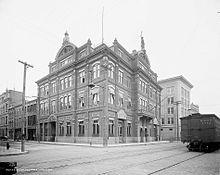
During the American Civil War, Mobile was a Confederate city. The first submarine to successfully sink an enemy ship, the H. L. Hunley, was built in Mobile. One of the most famous naval engagements of the war was the Battle of Mobile Bay, resulting in the Union taking possession of Mobile Bay on 5 August 1864. On 12 April 1865, 3 days after the surrender of Robert E. Lee at Appomattox Courthouse, the city of Mobile surrendered to the Union army to avoid destruction following the Union victories at the Battle of Spanish Fort and the Battle of Fort Blakely.
On 25 May 1865, the city suffered great loss when some three hundred people died as a result of an explosion at a federal ammunition depot on Beauregard Street. The explosion left a 30-foot (9 m) deep hole at the depot's location, sunk ships docked on the Mobile River, and the resulting fires destroyed the northern portion of the city.
Federal Reconstruction in Mobile began after the Civil War and effectively ended in 1874 when the local Democrats gained control of the city government. The last quarter of the 19th century was a time of economic depression and municipal insolvency for Mobile. One example can be provided by the value of Mobile's exports during this period of depression. The value of exports leaving the city fell from $9 million in 1878 to $3 million in 1882.
The turn of the 20th century brought the Progressive Era to Mobile and saw Mobile's economic structure evolve along with a significant increase in population. The population increased from around 40,000 in 1900 to 60,000 by 1920. During this time the city received $3 million in federal grants for harbor improvements to deepen the shipping channels in the harbor. During and after World War I, manufacturing became increasingly vital to Mobile's economic health, with shipbuilding and steel production being two of the most important.
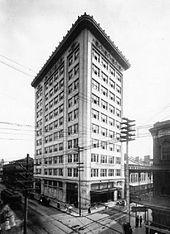
During this time, social justice and race relations in Mobile worsened, however. In 1902 the city government passed Mobile's first segregation ordinance, one that segregated the city streetcars. It legislated what had been informal practice, enforced by convention. Mobile's African-American population responded to this with a two-month boycott, but the law was not repealed. After this, Mobile's de facto segregation was increasingly replaced with legislated segregation as whites imposed Jim Crow laws to maintain dominance.
The red imported fire ant was first introduced into the United States via the Port of Mobile. Sometime in the late 1930s they came ashore off of South American cargo ships, where they lived in the soil used as ballast on those ships.
World War II led to a massive military effort causing a considerable increase in Mobile's population, largely due to the massive influx of workers coming to Mobile to work in the shipyards and at the Brookley Army Air Field. Between 1940 and 1943, more than 89,000 people moved into Mobile to work for war effort industries. Mobile was one of eighteen U.S. cities producing Liberty ships. Its Alabama Drydock and Shipbuilding Company supported the war effort by producing ships faster than the Axis powers could sink them. Gulf Shipbuilding Corporation, a subsidiary of Waterman Steamship Corporation, focused on building freighters, Fletcher class destroyers, and minesweepers.
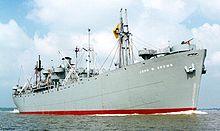
The years after World War II brought about changes in Mobile's social structure and economy. Replacing shipbuilding as a primary economic force, the paper and chemical industries began to expand, and most of the old military bases were converted to civilian uses. Following the war, African Americans stepped up their efforts to achieve equal rights and social justice. The police force and Spring Hill College were integrated in the 1950s and buses and lunch counters were voluntarily desegregated by the early 1960s.
In 1963 three African-American students brought a case against the Mobile County School Board for being denied admission to Murphy High School. The court ordered that the three students be admitted to Murphy for the 1964 school year, leading to the desegregation of Mobile County's school system. The Civil Rights Movement led to the end of legal racial segregation with passage of the Civil Rights Act of 1964.
Mobile's economy was dealt a severe blow in 1969 with the closing of Brookley Air Force Base. The closing left 10% of the workforce without employment. This and other factors ushered in a period of economic depression that lasted through the 1970s.
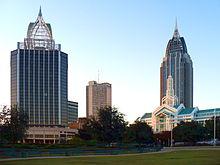
The Alabama legislature passed the Cater Act in 1949 allowing cities and counties to set up industrial development boards (IDB) to issue municipal bonds as incentives to attract new industry into their local areas. The city of Mobile did not establish a Cater Act board until 1962. George E. McNally, Mobile's first Republican mayor since Reconstruction, was the driving force behind its creation. The existing Mobile Area Chamber of Commerce, considering itself better qualified to attract new businesses and industry to the area, saw the new IDB as a serious rival. After several years of political squabbling, the Chamber of Commerce emerged victorious. While McNally's IDB prompted the Chamber of Commerce to become more proactive in attracting new industry, the chamber effectively shut Mobile city government out of economic development decisions.
Beginning in the late 1980s, newly elected mayor Mike Dow and the city council began an effort termed the "String of Pearls Initiative" to make Mobile into a competitive city. The city initiated construction of numerous new facilities and projects, and the restoration of hundreds of historic downtown buildings and homes. Violent crime was reduced, and city and county leaders attracted new business ventures to the area.
Mobile is located at 30 °40'46" North, 88 °6'12" West (30.679523, na88.103280), in the southwestern corner of the U.S. state of Alabama. According to the U.S. Census Bureau, the city has a total area of 159.4 square miles (413 km2), with 117.9 square miles (305 km2) of it being land, and 41.5 square miles (107.5 km2), or 26.1% of the total, being water. The elevation in Mobile ranges from 10 feet (3 m) on Water Street in downtown to 211 feet (64 m) at the Mobile Regional Airport.
Mobile has a number of notable historic neighborhoods. These include Ashland Place, Campground, Church Street East, De Tonti Square, Leinkauf, Lower Dauphin Street, Midtown, Oakleigh Garden, Old Dauphin Way, and Spring Hill.
Mobile's geographical location on the Gulf of Mexico provides a mild subtropical climate (Koppen Cfa), with hot, humid summers and mild, rainy winters. The record low temperature is na1 °F ( na18 °C), set on February 13, 1899, and the record high is 105 °F (41 °C), set on August 29, 2000.
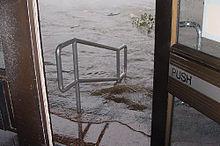
A 2007 study by WeatherBill, Inc. determined that Mobile is the wettest city in the contiguous 48 states, with 66.3 inches (1,680 mm) of average annual rainfall over a 30-year period. Mobile averages 120 days per year with at least 0.01 inches (0.3 mm) of rain. Snow is rare in Mobile, with the last snowfall being on February 12, 2010.
Mobile is occasionally affected by major tropical storms and hurricanes. Mobile suffered a major natural disaster on the night of 12 September 1979 when Category 3 Hurricane Frederic passed over the heart of the city. The storm caused tremendous damage to Mobile and the surrounding area. Mobile had moderate damage from Hurricane Opal on October 4, 1995 and Hurricane Ivan on September 16, 2004. Mobile also suffered millions of dollars in damage from Hurricane Katrina on August 29, 2005. A storm surge of 11.45 feet (3.49 m), topped by higher waves, damaged eastern sections of Mobile, with extensive flooding in downtown, Battleship Parkway, and the elevated Jubilee Parkway, destroying the electronic speed-limit fog-warning signals.
Mobile is home to an array of cultural influences with its mixed French, Spanish, Creole and Catholic heritage, in addition to British and African, distinguishing it from all other cities in the state of Alabama. The annual Carnival celebration is perhaps the best illustration of this. Mobile is the birthplace of Mardi Gras in the United States and has the oldest celebration, dating to the early 18th century during the French colonial period. Carnival in Mobile has evolved over the course of 300 years from a sedate French Catholic tradition into a mainstream multi-week celebration across the spectrum of cultures. Mobile's official cultural ambassadors are the Azalea Trail Maids, meant to embody the ideals of Southern hospitality.
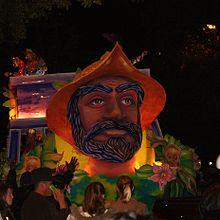
Mobile's Carnival celebrations start as early as November with several balls, with the parades usually beginning after January 5. Carnival celebrations end promptly at the stroke of midnight on Mardi Gras, signaling the beginning of Ash Wednesday and the first day of Lent. In Mobile, locals use the term Mardi Gras as a shorthand to refer to the entire Carnival season, although it literally means Fat Tuesday in French, the day before Ash Wednesday and the beginning of Lent. During this time Mobile's mystic societies build colorful Carnival floats and parade throughout downtown with masked society members tossing small gifts, known as throws, to parade spectators. Mobile's mystic societies, essentially private clubs, also give formal masquerade balls, which are almost always invitation only and are oriented to adults.
Mobile first celebrated Carnival in 1703 when French settlers began the festivities at the Old Mobile Site. Mobile's first Carnival society began in 1711 with the Boeuf Gras Society (Fatted Ox Society).
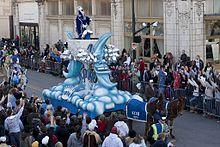
In 1830 Mobile's Cowbellion de Rakin Society was the first formally organized and masked mystic society in the United States to celebrate with a parade. The Cowbellions got their start when Michael Krafft, a cotton factor from Pennsylvania, began a parade with rakes, hoes, and cowbells. The Cowbellians introduced horse-drawn floats to the parades in 1840 with a parade entitled, "Heathen Gods and Goddesses". The Striker's Independent Society was formed in 1843 and is the oldest surviving mystic society in the United States.
Carnival celebrations in Mobile were canceled during the American Civil War. In 1866 Joe Cain revived the Mardi Gras parades when he paraded through the city streets on Fat Tuesday while costumed as a fictional Chickasaw chief named Slacabamorinico. He celebrated the day in front of the occupying Union Army troops. The year 2002 saw Mobile's Tricentennial celebrated with parades that represented all of Mobile's mystic societies.
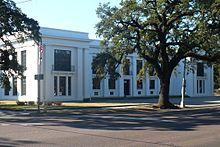
The National African American Archives and Museum features the history of African-American participation in Mardi Gras, authentic artifacts from the era of slavery, and portraits and biographies of famous African-Americans. The University of South Alabama Archives houses primary source material relating to the history of Mobile and southern Alabama, as well as the university's history. The archives are located on the ground floor of the USA Spring Hill Campus and are open to the general public. The Mobile Municipal Archives contains the extant records of the City of Mobile, dating from the city's creation as a municipality by the Mississippi Territory in 1814. The majority of the original records of Mobile's colonial history (1702 ae1813) are housed in Paris, London, Seville, and Madrid. The Mobile Genealogical Society Library and Media Center is located at the Holy Family Catholic Church and School complex. It features handwritten manuscripts and published materials for use in genealogical research. The Mobile Public Library system serves Mobile and consists of eight branches across Mobile County, featuring its own large local history and genealogy division housed in a facility next to the newly restored and enlarged Ben May Main Library on Government Street. The Saint Ignatius Archives, Museum and Theological Research Library contains primary sources, artifacts, documents, photographs and publications that pertain to the history of Saint Ignatius Church and School, the Catholic history of the city, and the history of the Roman Catholic Church.
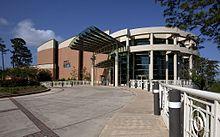
The Mobile Museum of Art features European, Non-Western, American, and Decorative Arts collections. The Saenger Theatre of Mobile was opened in 1927 and is a modern dynamic performing arts center. It is home to the Mobile Symphony, conducted by Maestro Scott Speck, and Space 301, a contemporary art gallery. It also serves as a small concert venue for the city. The Mobile Civic Center contains three facilities under one roof. The 400,000 sq ft (37,161 m2) building has an arena, a theater and an exposition hall. It is the primary concert venue for the city and hosts a wide variety of events. It is home to the Mobile Opera and the Mobile Ballet. The 60-year old Mobile Opera averages about 1,200 attendees per performance. A wide variety of events are held at Mobile's Arthur C. Outlaw Convention Center. It contains a 100,000 sq ft (9,290 m2) exhibit hall, a 15,000 sq ft (1,394 m2) grand ballroom, and sixteen meeting rooms. Additionally, the city sponsors BayFest, an annual three-day music festival with over 125 live musical acts on nine stages.
As for the stage, Mobile boasts the Mobile Theatre Guild, which is a flagship member of the Mobile Arts Council, the Alabama Conference of Theatre and Speech, the Southeastern Theatre Conference, and the American Association of Community Theatres. Mobile is also home to the Joe Jefferson Playhouse, Alabama's oldest continually-running community theatre.
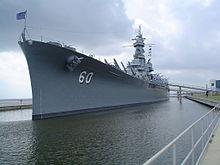
Mobile is home to a variety of museums. Battleship Memorial Park is a military park on the shore of Mobile Bay and features the World War II era battleship USS Alabama, the World War II era submarine USS Drum, Korean War and Vietnam War Memorials, and a variety of historical military equipment. The Museum of Mobile chronicles 300 years of Mobile history and material culture and is housed in the historic Old City Hall (1857). The Oakleigh Historic Complex features three house museums that interpret the lives of people from three levels of Mobile society in the mid-19th century. The Mobile Carnival Museum, which houses the city's Mardi Gras history and memorabilia, documents the variety of floats, costumes, and displays seen during the history of the festival season. The Bragg-Mitchell Mansion (1855), Richards DAR House (1860), and the Conde-Charlotte House (1822) are historic antebellum house museums. Fort Morgan, Fort Gaines, and Historic Blakeley State Park figure into local American Civil War history.
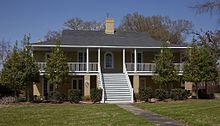
The Mobile Medical Museum is housed in the historic Vincent-Doan House (1827) and features artifacts and resources that chronicle the history of medicine in Mobile. The Phoenix Fire Museum is located in the restored Phoenix Volunteer Fire Company Number 6 building and features the history of fire companies in Mobile from their organization in 1838. The Mobile Police Department Museum features exhibits that chronicle the history of law enforcement in Mobile. The Gulf Coast Exploreum is a non-profit science center located in downtown. It features permanent and traveling exhibits, an IMAX dome theater, a digital 3D virtual theater, and a hands-on chemistry laboratory. The Dauphin Island Sea Lab is located south of the city near the mouth of Mobile Bay. It houses the Estuarium, an aquarium which illustrates the four habitats of the Mobile Bay ecosystem: the river delta, bay, barrier islands and Gulf of Mexico.
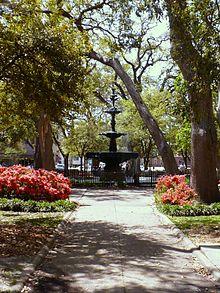
The Mobile Botanical Gardens feature a variety of flora spread over 100 acres (40 ha). It contains the Millie McConnell Rhododendron Garden with 1,000 evergreen and native azaleas and the 30-acre (12 ha) Longleaf Pine Habitat. The Bellingrath Gardens and Home are located on Fowl River and contain 65 acres (26 ha) of landscaped gardens and a 10,500 sq ft (975 m2) mansion dating to the 1930s. The 5 Rivers Delta Resource Center is a new facility for exploring the Mobile, Spanish, Tensaw, Appalachee, and Blakeley River delta. 5 Rivers Delta Resource Center was established by the state to be a gateway to the Mobile, Tensaw, Apalachee, Middle, Blakeley, and Spanish rivers that make up the Mobile-Tensaw River Delta. It contains a small theater; exhibit hall; meeting, wedding and party facilities; a several boat and adventure tours operated by 5 Rivers Delta Safaris; walking trails; and a canoe and kayak landing.
Mobile has more than 45 public parks with some that are of special interest. Bienville Square is a historic park dating to 1850 in the Lower Dauphin Street Historic District and is named for Mobile's founder, Jean-Baptiste Le Moyne, Sieur de Bienville. This park was once a principal gathering place for the citizens of the city and remains popular today. Cathedral Square is a performing arts park in the Lower Dauphin Street Historic District overlooked by the Cathedral Basilica of the Immaculate Conception. Fort Conde is a reconstruction of the original Fort Conde, built on the old fort's footprint. It is the city's official welcome center and living history museum. Spanish Plaza is a downtown park that honors the Spanish occupation of the city between 1780 and 1813. It features the "Arches of Friendship", a fountain presented to Mobile by the city of MR¡laga, Spain. Langan Park is a 720-acre (291 ha) municipal park that features lakes and natural spaces. It is home to the Mobile Museum of Art, Azalea City Golf Course, Mobile Botanical Gardens and Playhouse in the Park.
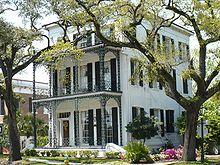
Mobile has antebellum architectural examples of Greek Revival, Gothic Revival, Italianate, and Creole cottage. Later architectural styles found in the city include the various Victorian types, shotgun types, Colonial Revival, Tudor Revival, Spanish Colonial Revival, Beaux-Arts and many others. The city currently has nine major historic districts consisting of Old Dauphin Way, Oakleigh Garden, Lower Dauphin Street, Leinkauf, De Tonti Square, Church Street East, Ashland Place, Campground, and Midtown.[100]
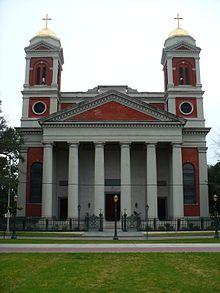
Mobile has a number of historic structures spread throughout the city. Some of Mobile's historic churches include Christ Church Cathedral, the Cathedral Basilica of the Immaculate Conception, Emanuel AME Church, Government Street Presbyterian Church, St. Louis Street Missionary Baptist Church, State Street AME Zion Church, Stone Street Baptist Church, Trinity Episcopal Church, St. Francis Street Methodist Church, Saint Joseph's Roman Catholic Church, Saint Francis Xavier Catholic Church, Saint Matthew's Catholic Church, Saint Paul's Episcopal Chapel, and Saint Vincent de Paul. The Sodality Chapel and St. Joseph's Chapel at Spring Hill College are two historic churches on that campus. Two historic Roman Catholic convents survive, the Convent and Academy of the Visitation and the Convent of Mercy.
Barton Academy is a historic Greek Revival school building and local landmark on Government Street. The Bishop Portier House and the Carlen House are two of the many surviving examples of Creole cottages in the city. The Mobile City Hospital and the United States Marine Hospital are both restored Greek Revival hospital buildings that predate the Civil War. The Washington Firehouse No. 5 is a Greek Revival fire station, built in 1851. The Hunter House is an example of the Italianate style and was built by a successful 19th century African American businesswoman. The Shepard House is a good example of the Queen Anne style. The Scottish Rite Temple is the only surviving example of Egyptian Revival architecture in the city. The Gulf, Mobile, and Ohio Passenger Terminal is an example of the Mission Revival style.
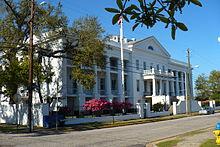
The city has several historic cemeteries that were established after the colonial era. They replaced Mobile's colonial Campo Santo, of which no traces remain. The Church Street Graveyard contains above-ground tombs and monuments spread over 4 acres (2 ha) and was founded in 1819, during the height of the yellow fever epidemics.[101] The nearby 120-acre (49 ha) Magnolia Cemetery was established in 1836 and was Mobile's primary burial site during the 19th century with approximately 80,000 burials.[102] It features tombs and many intricately carved monuments and statues.[103][104] The Catholic Cemetery was established in 1848 by the Archdiocese of Mobile and covers more than 150 acres (61 ha). It contains plots for the Brothers of the Sacred Heart, Little Sisters of the Poor, Sisters of Charity, and Sisters of Mercy, in addition to many other historically significant burials.[105] Mobile's Jewish community dates back to the 1820s and the city has two historic Jewish cemeteries, Ahavas Chesed Cemetery and Sha'arai Shomayim Cemetery.[106]
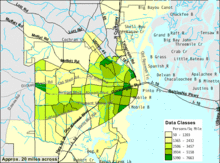
The 2010 census determined that there were 195,111 people residing within the city limits. Mobile is the center of Alabama's second-largest metropolitan area, which consists of all of Mobile County. Metropolitan Mobile had a population of 412,992 as of 2010 census.
2006 census estimates indicated that there were 73,057 households, out of which 22,225 had children under the age of 18 living with them, 29,963 were married couples living together, 15,360 had a female householder with no husband present, 3,488 had a male householder with no wife present, and 24,246 were non-families.[110] 20,957 of all households were made up of individuals and 7,994 had someone living alone who is 65 years of age or older.[110] The racial makeup of the city was 48.2% White, 47.9% Black or African American, 0.2% Native American, 1.8% Asian, 0.3% Pacific Islander, 0.5% from other races, 0.9% from two or more races, and 1.2% of the population were Latino.[110] Non-Hispanic Whites were 43.9% of the population in 2010,[111] down from 62.1% in 1980.[112] The average household size was 2.59 and the average family size was 3.23.[110] Same-sex couple households comprised 0.9% of all households.[113]
The population was spread out with 7.1% under the age of 5, 73.6% over 18, and 13.4% over 65.[110] The median age was 35.6 years.[110] The male population was 47.6% and the female population was 52.4%.[110] The median income for a household in the city was $37,439, and the median income for a family was $45,217.[110] The per capita income for the city was $21,612. 21.3% of the population and 17.6% of families were below the poverty line.[110]
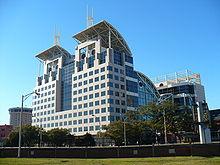
Since 1985 the government of Mobile has consisted of a mayor and a seven member city council.[114] The mayor is elected at-large and the council members are elected from each of the seven city council districts. A supermajority of five votes is required to conduct council business. This form of city government was chosen by the voters after the previous form of government, which used three city commissioners who were elected at-large, was ruled to substantially dilute the African American vote in the 1975 case Bolden v. City of Mobile.[115] Municipal elections are held every four years.
The current mayor, Sam Jones, was elected in September 2005 and is the first African American mayor of Mobile.[116] As of December 2011, the city council is composed of Fredrick Richardson, Jr. from District 1, William Carroll from District 2, Jermaine A. Burrell from District 3, John C. Williams from District 4, Reggie Copeland, Sr. from District 5, Bess Rich from District 6, and Gina Gregory from District 7. Reggie Copeland, Sr. is currently serving as Council President with Fredrick Richardson, Jr. serving as Council Vice President.[117]
In January 2008, the city hired EDSA, an urban design firm, to create a new comprehensive master plan for the downtown area and surrounding neighborhoods. The planning area is bordered on the east by the Mobile River, to the south by Interstate 10 and Duval Street, to the west by Houston Street and to the north by Three Mile Creek and the neighborhoods north of Martin Luther King Avenue.[118]
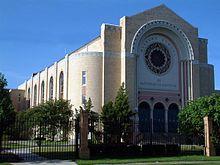
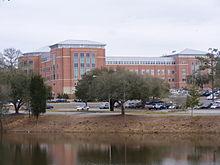
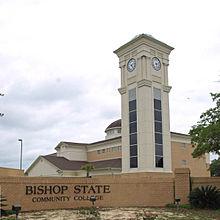
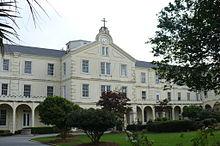
Public schools in Mobile are operated by the Mobile County Public School System. The Mobile County Public School System has an enrollment of over 65,000 students, employs approximately 8,500 public school employees, and had a budget in 2005 ae2006 of $617,162,616.[119] The State of Alabama operates the Alabama School of Mathematics and Science on Dauphin Street in Mobile, which boards advanced Alabama high school students. It was founded in 1989 to identify, challenge, and educate future leaders.[120]
Mobile also has a large number of private schools, most of them being parochial in nature. Many of these belong to the Roman Catholic Archdiocese of Mobile. The private Catholic institutions include McGill-Toolen Catholic High School (1896), Corpus Christi School, Little Flower Catholic School (1934), Most Pure Heart of Mary Catholic School (1900), Saint Dominic School (1961), Saint Ignatius School (1952), Saint Mary Catholic School (1867), Saint Pius X Catholic School (1957), and Saint Vincent DePaul Catholic School (1976).[121] The private Protestant institutions include St. Paul's Episcopal School (1947), Mobile Christian School (1961), St. Lukes Episcopal School (1961), Cottage Hill Baptist School System (1961), Faith Academy (1967), and Trinity Lutheran School (1955).[121] UMS-Wright Preparatory School (1893) is an independent, non-religious, co-educational preparatory school.[121]
Major colleges and universities in Mobile that are accredited by the Southern Association of Colleges and Schools include the University of South Alabama, Spring Hill College, the University of Mobile, Bishop State Community College, and Faulkner University.[122]
The University of South Alabama is a public, doctoral-level university established in 1963. The university is composed of the College of Arts and Sciences, the Mitchell College of Business, the College of Education, the College of Engineering, the College of Medicine, the Doctor of Pharmacy Program, the College of Nursing, the School of Computing, and the School of Continuing Education and Special Programs.[123]
Bishop State Community College, founded in 1927, is a public, historically African American, community college. Bishop State has four campuses in Mobile and offers a wide array of associate degrees.[124]
Faulkner University is a four-year private Church of Christ-affiliated university based in Montgomery, Alabama. The Mobile campus was established in 1975 and offers bachelor's degrees in Business Administration, Management of Human Resources, and Criminal Justice.[125] It also offers associate degrees in Business Administration, Business Information Systems, Computer & Information Science, Criminal Justice, Informatics, Legal Studies, Arts, and Science.[126]
Spring Hill College, chartered in 1830, was the first Catholic college in the southeastern U.S. and is the third oldest Jesuit college in the country.[127] This four-year private college offers graduate programs in Business Administration, Education, Liberal Arts, Nursing (MSN), and Theological Studies.[128] Undergraduate divisions and programs include the Division of Business, the Communications/Arts Division, International Studies, Inter-divisional Studies, the Language and Literature Division, Nursing (BSN), Philosophy and Theology, Political Science, the Sciences Division, the Social Sciences Division, and the Teacher Education Division.[129]
The University of Mobile is a four-year private Baptist-affiliated university that was founded in 1961. It consists of the College of Arts and Sciences, School of Business, School of Christian Studies, School of Education, the School of Leadership Development, and the School of Nursing.[130]
Several other post-secondary institutions have a campus in Mobile, including the Alabama Institute Of Real Estate, American Academy Of Hypnosis, Bealle School Of Real Estate, Charles Academy Of Beauty Culture, Fortis College, Virginia College, ITT Technical Institute, Remington College and White And Sons Barber College.[122]
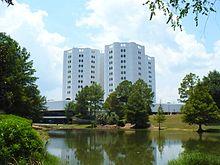
Mobile serves the central Gulf Coast as a regional center for medicine, with over 850 physicians and 175 dentists. There are four major medical centers within the city limits: Mobile Infirmary Medical Center with 704 beds, Springhill Medical Center with 252 beds, Providence Hospital with 349 beds, and the University of South Alabama Medical Center with 346 beds and a level I trauma center.[131] Additionally, the University of South Alabama also operates USA Children's & Women's Hospital with 219 beds, dedicated exclusively to the care of children and women, and Mobile Infirmary Medical Center operates Infirmary West with 100 acute care beds.[131] In 2008, the University of South Alabama opened the USA Mitchell Cancer Center Institute. The center is home to the first academic cancer research center in the Gulf Coast region.[132] BayPointe Hospital and Children's Residential Services is a 94-bed psychiatric hospital that houses a residential unit for children, an acute unit for children and adolescents, and an involuntary hospital unit for adults undergoing evaluation ordered by the Mobile Probate Court.[133] The city has a broad array of outpatient surgical centers, emergency clinics, home health care services, assisted-living facilities and skilled nursing facilities.[131][134]
Aerospace, steel, ship building, retail, services, construction, medicine, and manufacturing are Mobile's major industries. After experiencing economic decline for several decades, Mobile's economy began to rebound in the late 1980s. Between 1993 and 2003 roughly 13,983 new jobs were created as 87 new companies were founded and 399 existing companies were expanded.[135]
Defunct companies that were founded or based in Mobile included Alabama Drydock and Shipbuilding Company, Delchamps, and Gayfers. Current companies that were formerly based in the city include Checkers, Minolta-QMS, Morrison's, and the Waterman Steamship Corporation. In additional to those discussed below, current companies that operate out of Mobile include AlwaysHD, Foosackly's, and Integrity Media.
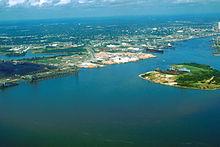
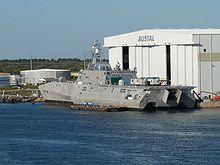
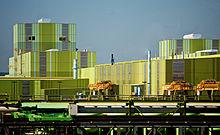
The United States Department of Labor's Bureau of Labor Statistics estimated an unemployment rate at 8.5% for the Mobile Metropolitan Statistical Area in March 2012, compared with a seasonally adjusted rate of 7.4% for the state as a whole.[136]
Mobile's Alabama State Docks underwent the largest expansion in its history by expanding its container processing and storage facility and increasing container storage at the docks by over 1,000% at a cost of over $300 million, thus positioning Mobile for rapid container processing growth.[137] As of 2008, the Port of Mobile was the 9th largest by tonnage in the United States.
Shipbuilding began to make a major comeback in Mobile in 1999 with the founding of Austal USA.[138] A subsidiary of the Australian company Austal, it expanded its production facility for U.S. defense and commercial aluminum shipbuilding on Blakeley Island in 2005.[139] Austal announced in November 2010, upon winning another multi billion dollar defense contract, it will yet again expand its facilities in downtown and add additional jobs.
Atlantic Marine operated a major shipyard at the former Alabama Drydock and Shipbuilding Company site on Pinto Island. It was acquired by British defense conglomerate BAE Systems in May 2010 for $352 million. Doing business as BAE Systems Southeast Shipyards, the company continues to operate the site as a full-service shipyard, employing approximately 600 workers.[140][141][142]
The Brookley Aeroplex is an industrial complex and airport located 3 miles (5 km) south of the central business district of the city. It is currently the largest industrial and transportation complex in the region with over 70 companies, many of which are aerospace, spread over 1,650 acres (668 ha).[143] Notable employers at Brookley include Airbus North America Engineering (Airbus Military North America's facilities are at the Mobile Regional Airport), ST Aerospace Mobile (a division of ST Engineering), and Continental Motors.[144]
Plans for a Mobile aircraft assembly plant were formally announced by Airbus CEO Fabrice Bregier from the Mobile Convention Center on 2 July 2012. The plans include a $600 million factory at the Brookley Aeroplex for the assembly of the A319, A320 and A321 aircraft, all part of Airbus A320 family. It could employ up to 1,000 full-time workers when operational. Construction is scheduled to begin in 2013, with it becoming operable by 2015 and producing up to 50 aircraft per year by 2017.[145][146] The assembly plant is the company's first factory to be built within the United States.[147]
German technology conglomorate ThyssenKrupp broke ground on a $4.65 billion combined stainless and carbon steel processing facility in Calvert, a few miles north of Mobile, in 2007. It was originally projected to eventually employ 2,700 people. The facility became operational in July 2010.[148][149]
The company put its carbon mill in Calvert and a steel slab-making unit in Rio de Janeiro both up for sale in May 2012, citing rising production costs and a worldwide slump in demand.[150] ThyssenKrupp's stainless steel division, Inoxum, including the stainless portion of the Calvert plant, was sold to Finnish stainless steel company Outokumpu Oyi in 2012.[151]
According to Mobile's 2011 Comprehensive Annual Financial Report, the top employers in the city during 2011 were:[152]
Local airline passengers are served by the Mobile Regional Airport, with direct connections to five major hub airports: Charlotte, Dallas, Atlanta, Houston, and Memphis.[153] It is served by American Eagle Airlines (with service to Dallas-Fort Worth International Airport), United Express (with service to George Bush Intercontinental Airport), Delta Connection (with service to Hartsfield-Jackson International Airport and Memphis International Airport), and US Airways Express (with service to Charlotte/Douglas International Airport).[153] The Mobile Downtown Airport serves corporate, cargo, and private aircraft.[153]
Mobile is served by four Class I railroads, including the Canadian National Railway (CNR), CSX Transportation (CSX), the Kansas City Southern Railway (KCS), and the Norfolk Southern Railway (NS).[154] The Alabama and Gulf Coast Railway (AGR), a Class III railroad, links Mobile to the Burlington Northern and Santa Fe Railway (BNSF) at Amory, Mississippi. These converge at the Port of Mobile, which provides intermodal freight transport service to companies engaged in importing and exporting. Other railroads include the CG Railway (CGR), a rail ship service to Coatzacoalcos, Veracruz, and the Terminal Railway Alabama State Docks (TASD), a switching railroad.[154] The city was served by Amtrak's Sunset Limited passenger train service until 2005, when the service was suspended because of the effects of Hurricane Katrina. [155][156]
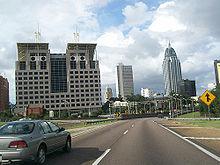
Two major interstate highways and a spur converge in Mobile. Interstate 10 runs northeast to southwest across the city while Interstate 65 starts in Mobile at Interstate 10 and runs north. Interstate 165 connects to Interstate 65 north of the city in Prichard and joins Interstate 10 in downtown Mobile.[157] Mobile is well served by many major highway systems. United States Highways US 31, US 43, US 45, US 90 and US 98 radiate from Mobile traveling east, west, and north. Mobile has three routes east across the Mobile River and Mobile Bay into neighboring Baldwin County, Alabama. Interstate 10 leaves downtown through the George Wallace Tunnel under the river and then over the bay across the Jubilee Parkway to Spanish Fort/Daphne. US 98 leaves downtown through the Bankhead Tunnel under the river onto Blakeley Island and then over the bay across the Battleship Parkway into Spanish Fort, Alabama. US 90 travels over the Cochrane aeAfricatown USA Bridge to the north of downtown onto Blakeley Island where it becomes co-routed with US 98.[157]
Mobile's public transportation is the Wave Transit System which features buses with 18 fixed routes and neighborhood service.[158] Baylinc is a public transportation bus service provided by the Baldwin Rural Transit System in cooperation with the Wave Transit System that provides service between eastern Baldwin County and downtown Mobile. Baylinc operates Monday through Friday.[159] Greyhound Lines provides intercity bus service between Mobile and many locations throughout the United States. Mobile is served by several taxi and limousine services.[160]

The Port of Mobile has public, deepwater terminals with direct access to 1,500 miles (2,400 km) of inland and intracoastal waterways serving the Great Lakes, the Ohio and Tennessee river valleys (via the Tennessee-Tombigbee Waterway), and the Gulf of Mexico.[154] The Alabama State Port Authority owns and operates the public terminals at the Port of Mobile.[154] The public terminals handle containerized, bulk, breakbulk, roll-on/roll-off, and heavy-lift cargoes.[154] The port is also home to private bulk terminal operators, as well as a number of highly specialized shipbuilding and repair companies with two of the largest floating dry docks on the Gulf Coast.[154]
The city was the home port for Carnival Cruise Lines' Carnival Elation cruise ship.[161] The first cruise ship to call the port home was the Holiday, which left the city in November 2009 so that a larger and newer ship could take its place. The Carnival Fantasy operated from Mobile from then until the Carnival Elation arrived in May 2010.[162] In early 2011, Carnival announced that despite fully booked cruises the company would cease operations from Mobile in October 2011.
Mobile's Press-Register is Alabama's oldest active newspaper, dating back to 1813.[163] The paper focuses on Mobile and Baldwin counties and the city of Mobile, but also serves southwestern Alabama and southeastern Mississippi.[163] Mobile's alternative newspaper is the Lagniappe.[164] The Mobile area's local magazine is Mobile Bay Monthly.[165] The Mobile Beacon is an alternative focusing on the African-American communities of Mobile. Mod Mobilian is a website with a focus on cultured-living in Mobile.[166]
Mobile is served locally by four television stations: WPMI 15 (NBC), WKRG 5 (CBS), WALA 10 (Fox), and WFNA 55 (CW).[167] The regional area is also served by WEAR 3 (ABC) and WJTC 44, an independent station. They are both based in Pensacola, Florida. Mobile is included in the Mobile ae Pensacola ae Fort Walton Beach designated market area, as defined by Nielsen Media Research, and is ranked 61st in the United States for the 2007 ae08 television season.[168]
Fourteen FM radio stations transmit from Mobile: WAVH, WBHY, WBLX, WDLT, WHIL, WKSJ, WKSJ-HD2, WLVM, WMXC, WMXC-HD2, WQUA, WRKH, WRKH-HD2, and WZEW . Nine AM radio stations transmit from Mobile: WABB, WBHY, WGOK, WIJD, WLPR, WMOB, WNGL, WNTM, and WXQW. The content ranges from Christian Contemporary to Hip hop to Top 40.[169] Arbitron ranks Mobile's radio market as 93rd in the United States as of autumn 2007.[170]
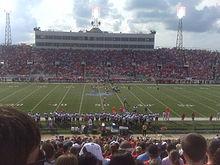
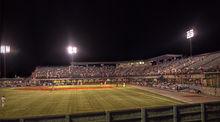
Mobile is the home of Ladd-Peebles Stadium. The football stadium opened in 1948. With a current capacity of 40,646, Ladd-Peebles Stadium is the 4th largest stadium in the state.[171] Ladd-Peebles Stadium has been home to the Senior Bowl since 1951, featuring the best college seniors in NCAA football.[172] The GoDaddy.com Bowl formerly the GMAC Bowl has been played since 1999 featuring opponents from the Mid-American Conference and Conference USA.[173] Since 1988, Ladd-Peebles Stadium has hosted the Alabama-Mississippi All-Star Classic. The top graduating high school seniors from their respective states compete each June.[174] Ladd Stadium also hosts home games for the University of South Alabama football, which went undefeated in its 2009 inaugural season. The football program will move to Division I/FBS in 2013 as a member of the Sun Belt Conference. South Alabama basketball is a respected mid-major, regularly competing for the Sun Belt Conference championship. South Alabama baseball also has a proud tradition, producing professional stars such as Luis Gonzalez, Juan Pierre, Jon Lieber, Adam Lind, and David Freese. The public Mobile Tennis Center includes over 50 courts, all lighted and hard-court.[175] For golfers, Magnolia Grove, part of the Robert Trent Jones Golf Trail, has 36 holes. The Falls course was recently named the best par 3 course in America.[176] Since 1999, the LPGA Tournament of Champions has been played annually at Magnolia Grove. The Crossings course is home of this tournament. Beginning in 2008, the Bell Micro LPGA Classic will also be held in Mobile. Mobile is also home to the Azalea Trail Run, which races through historic midtown and downtown Mobile. This 10k run has been an annual event since 1978.[177] The Azalea Trail Run is one of the premier 10k road races in the U.S., attracting runners from all over the world.[178] Mobile's Hank Aaron Stadium is the home of the Mobile BayBears minor league baseball team.[179] As of December 2007, Mobile's University of South Alabama approved a NCAA Football program to be played at Ladd-Peebles Stadium.[180] On June 8, 2010, the American Basketball Association announced that a team would be starting in the Mobile Area. The team will be named the Mobile Bay Hurricanes and will play its home games on the campus of Davidson High School. Also in 2010, the Southern Indoor Football League announced that a team would be formed in the Mobile Area. The team will be called the Mobile Bay Tarpons and will play its home games at the Mitchell Center.
Mobile has registered sister city arrangements with the following cities:[181][182][183]
Additionally, it has pending sister city arrangements with:[181]
Former sister cities:[181]
Word Count: 8614






